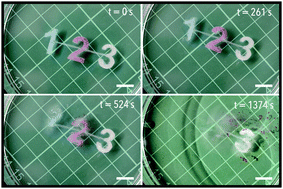Temporal and spatial programming in soft composite hydrogel objects†
Abstract
Soft composite hydrogel objects formed from the biopolymer sodium alginate, the enzyme urease, and oil droplets are formed by a simple gelation procedure to produce autonomous bodies with both time and spatial programming. These continuous objects of non-uniform dimensional composition selectively respond to an environmental stimulus of urea and change colour or disintegrate at pre-defined locations within the hydrogel structure after pre-set time intervals. The spatial and temporal responses of these hydrogels to an environmental stimulus are valuable tools in areas such as soft robotics.



 Please wait while we load your content...
Please wait while we load your content...